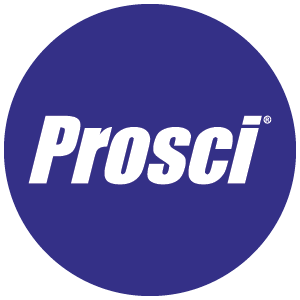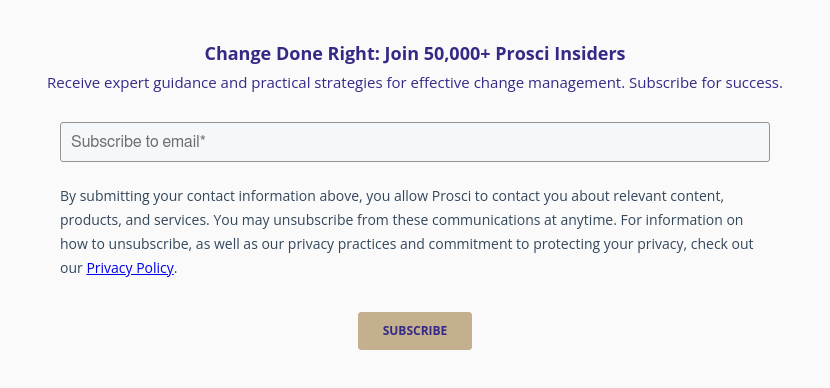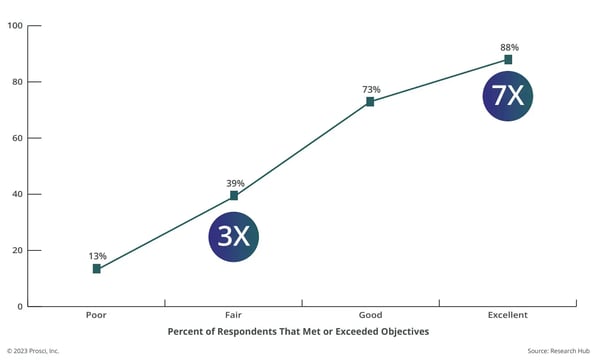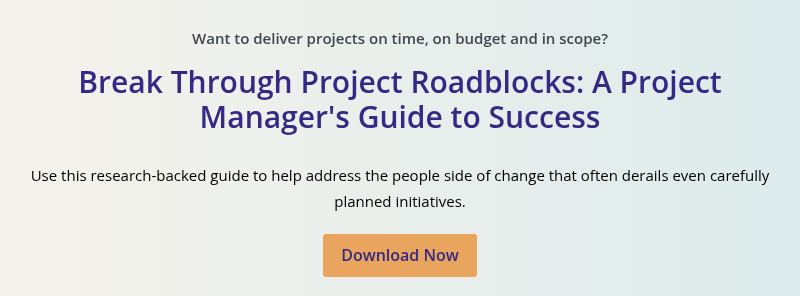How to Choose the Right Digital Transformation Framework

8 Mins
Updated: August 7, 2025
Published: June 18, 2025

Many organizations embark on digital transformation to remain competitive and relevant, yet many struggle to achieve meaningful and lasting results.
True transformation requires deep organizational change, employee adoption and cultural alignment. Digital transformation frameworks help guide this complex process, offering structured approaches to manage complex change, but even the best framework can fall short without effective change management.
This comprehensive guide explores what digital transformation frameworks are, why they matter, and how to use them effectively. We’ll also explore how integrating Prosci’s human-centered change management models and methodology can dramatically increase the success of any transformation initiative.
What Is a Digital Transformation Framework?
A digital transformation framework is a strategic blueprint for planning and managing complex, technology-driven change across an organization.
It connects digital efforts to business goals and lays out a clear path to follow, and helps teams stay aligned and focused on shared outcomes. Digital transformation frameworks typically include actionable steps to:
- Define transformation goals and outcomes
- Align digital transformation strategy with business strategy
- Identify required technologies and integrations
- Restructure operations and workflows
- Engage employees across departments
A structured framework supports your digital transformation journey’s success and makes change more likely to last.
Why Digital Transformation Frameworks Matter
Digital transformation reshapes the way you operate, deliver value and engage people at every level. Without a clear framework to support the digital transformation process, your efforts can easily become fragmented, driven by short-term fixes rather than long-term strategy.
A strong framework brings structure and direction to complex change. It ensures every digital transformation initiative is aligned with strategic goals and supported by the right people, business processes and digital technologies.
Key benefits of digital transformation frameworks include:
- Strategic alignment – Connects digital investments to business priorities.
- Cross-functional coordination – Promotes collaboration across departments under a unified plan.
- Risk mitigation – Flags challenges early so they can be addressed proactively.
- Scalability – Makes it possible to expand successful transformations across regions or business units.
- Performance tracking – Establishes clear metrics to monitor progress and results.
Without this foundation, you run the risk of adopting isolated solutions that fail to scale, integrate or deliver lasting impact.
Common Types of Digital Transformation Frameworks
There’s no one-size-fits-all approach to digital transformation projects. The right framework depends on your common goals, structure and industry. Understanding the most common types of transformation frameworks can help you choose the right one and apply it effectively.
Below are four popular digital transformation frameworks, each designed to guide successful execution across every stage.
1. Enterprise architecture frameworks
Enterprise architecture frameworks align technology systems with business strategy through structured planning and governance.
These frameworks offer a holistic approach to architecture design, covering everything from data flows and systems to processes and organizational structures. They support informed decisions by providing clear models and standards for how digital technologies and business operations should work together.
Benefits of enterprise architecture frameworks include:
- Standardization across systems, digital platforms and processes
- Improved integration of technologies and data flows
- Greater visibility for long-term infrastructure planning
- Future-proof architecture that supports sustainable transformation
Enterprise architecture frameworks are best suited to complex infrastructures. They’re particularly useful during the foundational stages of transformation or when restructuring enterprise-wide systems.
A well-known example of an enterprise architecture framework is the Zachman Framework. It uses a matrix to define enterprise architecture across six key questions—what, how, where, who, when and why—viewed through six different stakeholder lenses. The result is a complete model of how your business functions and how advanced technologies supports each layer.
Zachman Framework

2. Process-centric frameworks
Process-centric frameworks focus on improving how work gets done. They optimize operations, reduce inefficiencies and boost performance by applying structured, continuous improvement methodologies. These frameworks provide effective tools to analyze workflows, eliminating waste and inefficiencies across the business.
Benefits of process-centric frameworks include:
- Streamlined operations and faster cycle times
- Improved resource utilization and cost control
- Higher performance through repeatable, optimized processes
- Data-driven insights for ongoing improvement
This type of digital transformation framework is ideal for organizations focused on operational excellence. It’s especially effective in manufacturing, logistics and healthcare industries, where process performance directly affects outcomes and customer value.
A common process-centric framework is Lean Six Sigma DMAIC. This framework follows five steps—Define, Measure, Analyze, Improve and Control—to identify ongoing process problems, implement targeted solutions and sustain improvements over time. It combines data analysis with disciplined process control to drive measurable, lasting results from your digital journey.
Lean Six Sigma DMAIC Methodology

3. Agile and innovation frameworks
Agile and innovation frameworks prioritize adaptability, speed and customer-centric design. They support iterative development and quick feedback loops, so you can respond quickly to changing needs, test new ideas, and bring innovations to market faster. These frameworks help you stay focused on delivering value early and often.
Benefits of Agile and innovation frameworks include:
- Accelerated product and service development cycles
- Improved customer experiences through ongoing feedback
- Greater flexibility in adapting to change
- Stronger collaboration across cross-functional teams
Frameworks like these are ideal for fast-paced industries where innovation is critical. They’re widely used in software development, tech startups and product-driven businesses, but can benefit any organization that values responsiveness and experimentation.
A leading example is the Agile methodology, which breaks work into short iterations or “sprints.” Teams deliver working solutions incrementally, gather real-time input, and adjust plans as needed. This framework drives continuous improvement and keeps teams aligned with customer experimentation and needs.

4. Hybrid frameworks
Hybrid frameworks combine critical elements from multiple transformation models to create a tailored approach that fits your digital transformation objectives and challenges. By blending different methodologies, hybrid frameworks allow you to tackle digital transformation from several angles at once.
Benefits of hybrid frameworks include:
- Flexibility to adapt tools and methods to different teams or digital initiatives
- Comprehensive coverage across people, processes and technology
- Ability to scale transformation efforts while maintaining consistency
- Strong alignment between strategic planning and tactical execution
Hybrid frameworks are a good option for diverse needs or large-scale digital initiatives that span departments, systems and geographies.
For example, a global healthcare provider might use enterprise architecture to modernize IT infrastructure, Lean Six Sigma to streamline clinical workflows, and Agile to improve patient-facing digital tools. This comprehensive approach supports operational efficiency and innovation, without forcing teams into a single rigid model.

The Human Factor: Why Frameworks Alone Are Not Enough
Digital transformation frameworks provide structure, consistency and direction. But they often overlook the most powerful force in any transformation: people.
Prosci’s report, Beyond the Technology: Navigating the Human Side of Digital Transformation, found that the top barriers to success stemmed primarily from human factors, including:
- Insufficient stakeholder engagement and management
- Lack of leadership commitment or support
- Inadequate education and awareness of change management
- Misaligned culture, attitudes or beliefs
Greatest Change Management Obstacles in Digital Transformations

These findings make one thing clear: transformation fails when people don’t understand the change, aren’t ready for it, or don’t support it. Challenges like poor communication or unclear expectations can slow momentum and stall progress, regardless of the framework's strength.
Successful digital transformation requires active leadership, early engagement, and a clear plan to support the people impacted by it every step of the way.
Our research shows that organizations with excellent change management programs are seven times more likely to meet their strategic objectives. That’s the difference between change in theory and change done right.
Correlation of Change Management Effectiveness With Meeting Objectives

Digital Transformation Challenges—and How To Overcome Them With Change Management
Even with a solid framework, failing to address the people side of change can cause your digital transformation efforts to under-deliver. In this section, we’ll explore four common challenges of digital transformation—and how to solve them by taking a human-centric approach to change management.
Lack of support from employees and management
One of the most common and costly barriers to digital transformation is inadequate support. Commitment quickly fades when employees feel disconnected or uncertain about what’s changing and why. Without active leadership commitment, transformation efforts lose momentum, creating confusion and missed opportunities.
How change management helps
Change management provides a structured approach to earning support at every level. The Prosci ADKAR® Model plays a key role in supporting individual change, particularly in addressing elements that, when missing, lead to greater resistance–Awareness of the need for change and Desire to change.
Awareness ensures people understand the need for change. Business leaders should become visible sponsors of change, communicating clearly and frequently about why the change is needed. This includes discussing the risks of not changing and how the change aligns with organizational goals. Engaging employees in discussions about change builds awareness and reduces skepticism.
Desire fosters a willingness among employees to support and participate in the change. To address personal concerns, involve employees in the change process; actively seek their input, share success stories, and demonstrate how the change will benefit them personally.
Early engagement, consistent messaging and visible sponsorship build trust and alignment. Our Best Practices in Change Management report shows that active and visible executive sponsorship is consistently the top contributor to successful change, including digital transformation efforts, cited by 26% of change professionals. When employees and leaders understand the “why,” they’re more likely to engage, commit and become champions of change.
The Prosci ADKAR Model

Poor communication of the transformation vision
In any digital transformation strategy, clarity is key. Without a well-communicated vision, people are left to fill in the gaps. Misunderstandings arise, trust erodes and alignment fades. Employees may struggle to see how the transformation affects their role—or why it matters at all.
When employees don’t see the connection between their work and the broader goals, motivation and engagement decline. Confusion and uncertainty slow progress, making it harder to sustain change.
How change management helps
A structured change management approach creates communication that’s intentional, consistent and aligned with individual needs. Our ADKAR Model highlights the importance of using Knowledge-building and Reinforcement activities to support people and keep them engaged throughout the digital transformation process. It guides leaders to share not just what’s changing, but how employees need to behave differently, and how success will be measured over time.
Knowledge equips individuals with the information and skills they need to implement the change. Tailored training and resources, role-specific messaging, and two-way communication help everyone understand and connect with the vision.
Reinforcement makes it more likely that change will be sustained in the long term. Milestone recognition, regular updates, open feedback systems, and clear communication from leadership help to embed change into the organizational culture.
According to Prosci research, frequent and open communication was a top contributor to success in digital transformation initiatives, cited by 10% of practitioners. With the right communication strategy, change becomes something people understand and support.
Insufficient training and enablement
Digital transformation often requires employees to work with unfamiliar digital tools, systems and workflows. Without effective training and enablement, employees may feel overwhelmed or unprepared for changes. This can lead to reduced productivity, ineffective technology adoption and missed outcomes.
Unstructured or one-size-fits-all training programs rarely meet the needs of a diverse workforce. When employees lack the skills or confidence to apply new processes, progress slows and frustration grows.
How change management helps
Change management positions training as a strategic enabler of transformation. The ADKAR Model emphasizes the importance of Ability and Reinforcement—the moments when knowledge becomes action, and action becomes habit.
Ability helps individuals gain competence in real-world contexts. By providing hands-on training, sandbox environments and just-in-time learning resources, change leaders can equip employees with the capability to implement the change effectively.
Reinforcement supports the ongoing application of new skills and knowledge. Refresher courses, peer support networks, and manager coaching keep employees engaged and proficient in new tools and systems.
Prosci research shows that organizations with strong employee engagement and participation, cited by 18% of practitioners, are significantly more likely to meet digital transformation goals. Capability builds confidence. And confidence powers change.
Greatest Contributors to Change Success in Digital Transformations

Cultural resistance to new ways of working
Digital transformation initiatives may challenge long-standing norms, habits and power structures. When these disruptions clash with deeply rooted beliefs or ways of working, cultural resistance can emerge.
Employees may feel uncertain about their place in the new environment. They might fear that what made them successful in the past is no longer valued. This can lead to disengagement, low morale or quiet pushback that slows transformation.
How change management helps
Change management offers a people-centered approach to shifting beliefs and behaviors. Our ADKAR Model highlights Desire and Reinforcement as essential for enabling lasting cultural change.
Desire ensures that individuals are not only willing to change but are internally motivated to support it. Tactics such as involving employees in co-creating the future state, showing personal relevance, and involving employees in change discussions help foster trust and ownership.
Reinforcement solidifies that shift by aligning rewards, recognition and leadership behaviors with the desired culture. Feedback mechanisms, integrated performance evaluations and continuous communication about the positive impact of the change contribute to sustained success.
According to Prosci research, misaligned culture and attitudes were a top obstacle in digital transformation for 13% of practitioners. By embedding these people-centered change management strategies into the transformation framework, you can shift the culture and create a more adaptable, innovative workforce.
Making Digital Transformation Work—With People at the Center
Digital transformation frameworks offer essential structure for aligning strategy, technology and execution. But lasting success depends on the way people engage with the change; how they understand it, adopt new ways of working, and help carry it forward.
Change management brings the human element into focus. With decades of research and a proven, people-centered methodology, Prosci helps you prepare your employees, activate leadership and embed the practices needed for sustained change.
Whether you're modernizing systems or reshaping how your organization works, you can build the capabilities you need to lead change—at every level, and for the long term.




